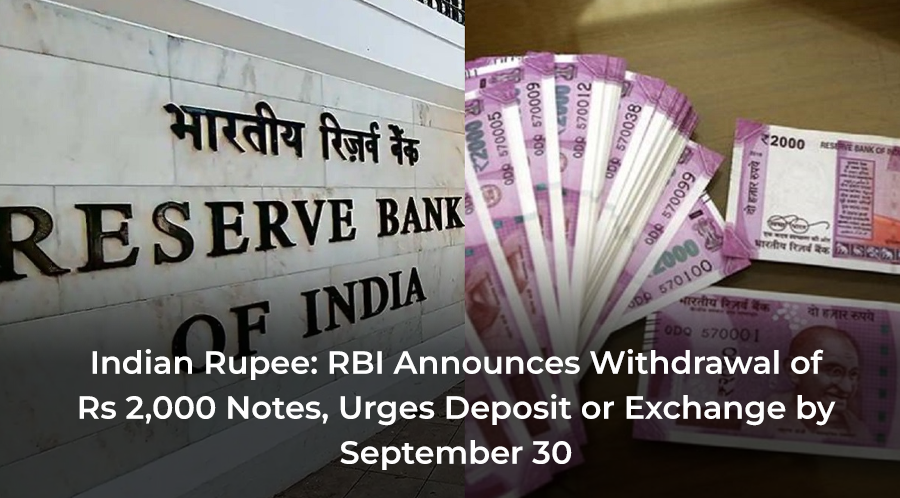Indian Rupee: RBI Announces Withdrawal of Rs 2,000 Notes, Urges Deposit or Exchange by September 30
Arun Kumar 22 May 2023
The Reserve Bank of India (RBI) made an announcement on Friday regarding the withdrawal of the highest-value currency note, the Rs 2,000 note, from circulation. However, it clarified that these notes will still retain their status as legal tender. The RBI stated that existing Rs 2,000 notes can be either deposited or exchanged in banks until September 30. It also set a limit of "Rs 20,000 at a time" for such transactions.
The central bank has recommended that the general public deposit or exchange their Rs 2,000 notes, which were introduced during the demonetization process in November 2016 when Rs 500 and Rs 1,000 notes were phased out. Individuals are advised to deposit these notes into their bank accounts or exchange them for notes of different denominations at any bank branch. Additionally, banks have been instructed to cease the issuance of Rs 2,000 notes with immediate effect.
To ensure operational convenience and prevent disruption of regular banking activities, the exchange of Rs 2,000 banknotes can be conducted up to a limit of Rs 20,000 at a time, at any bank, starting from May 23, according to the RBI's statement.
In order to ensure timely completion of the exercise and to allow sufficient time for the general public, all banks will offer the facility to deposit and/or exchange Rs 2,000 banknotes can be deposited or exchanged until September 30, 2023," as stated by the RBI.
The RBI stated that deposits into bank accounts can be made in a regular manner, without any limitations, following existing instructions and relevant statutory provisions.
From May 23 onwards, the exchange facility for Rs 2,000 notes, up to a limit of Rs 20,000 at a time, will also be available at the 19 regional offices of the RBI that have issue departments.
Shortly after the announcement, a senior official from the Reserve Bank of India, when contacted by The Indian Express, clarified that this is a routine exercise, citing a similar withdrawal of currency notes printed before 2005 conducted by the government in 2013-2014. Therefore, no further implications should be inferred from this current move, as other countries, including the United States, also engage in such actions periodically.
When asked about the rationale behind the decision, the RBI official cited several factors. Firstly, there was a concern regarding the accumulation of worn-out Rs 2,000 notes within the RBI. Furthermore, these notes have not gained widespread popularity, leading to many of them remaining unused. Having reached the end of their intended lifespan, even at their peak circulation, they accounted for only a small fraction of the overall currency, approximately 10% to 11%. In contrast, during the demonetization of Rs 500 and Rs 1,000 notes in 2016, those denominations constituted around 80% of the total currency in circulation, illustrating a significant disparity.
Regarding consultation with the Finance Ministry, the official stated that a decision of this nature would not be made by the RBI alone. Collaboration and consultation with relevant authorities would be involved.
According to the RBI, around 89% of the Rs 2,000 denomination notes were issued prior to March 2017 and have already surpassed their estimated lifespan of four to five years. The total value of these banknotes in circulation has gradually declined from its peak of Rs 6.73 lakh crore (37.3% of total notes in circulation) as of March 31, 2018, to Rs 3.62 lakh crore, constituting merely 10.8% of notes in circulation as of March 31, 2023.
It is noteworthy that the RBI had previously implemented a similar withdrawal of notes from circulation in 2013-2014, as part of its routine practices.
According to the RBI, approximately 89% of the Rs 2,000 denomination notes were issued before March 2017 and have reached the end of their estimated lifespan of four to five years. The total value of these banknotes in circulation has decreased from Rs 6.73 lakh crore at its peak on March 31, 2018 (accounting for 37.3% of all notes in circulation) to Rs 3.62 lakh crore, representing only 10.8% of notes in circulation as of March 31, 2023. In 2013-2014, the RBI had previously withdrawn notes from circulation in a similar manner.
The introduction of the Rs 2,000 note in November 2016, under Section 24(1) of the RBI Act, 1934, aimed to swiftly fulfill the currency demand of the economy after the withdrawal of legal tender status for all Rs 500 and Rs 1,000 notes then in circulation. The purpose of introducing Rs 2,000 banknotes was achieved once an ample quantity of banknotes in other denominations became available. As a result, the printing of Rs 2,000 banknotes was discontinued during the fiscal year 2018-19. The RBI noted that this denomination is not commonly used for transactions and that an adequate stock of banknotes in other denominations continues to meet the public's currency requirements.
Get in Touch With us
Register here and Avail the Best Offers!!





